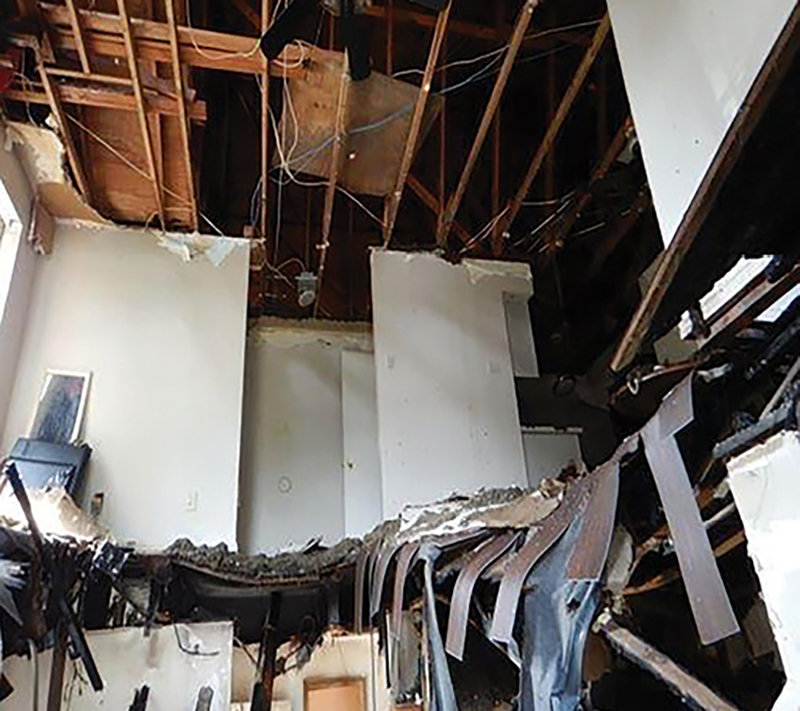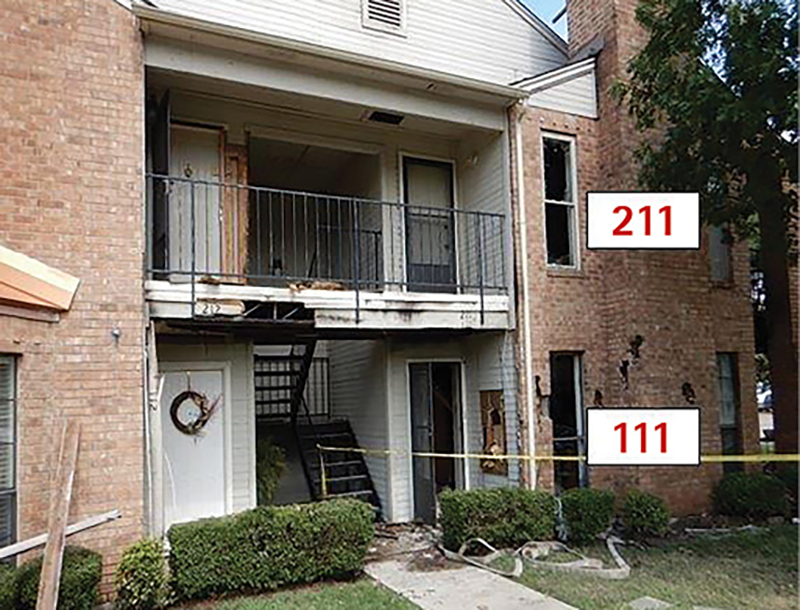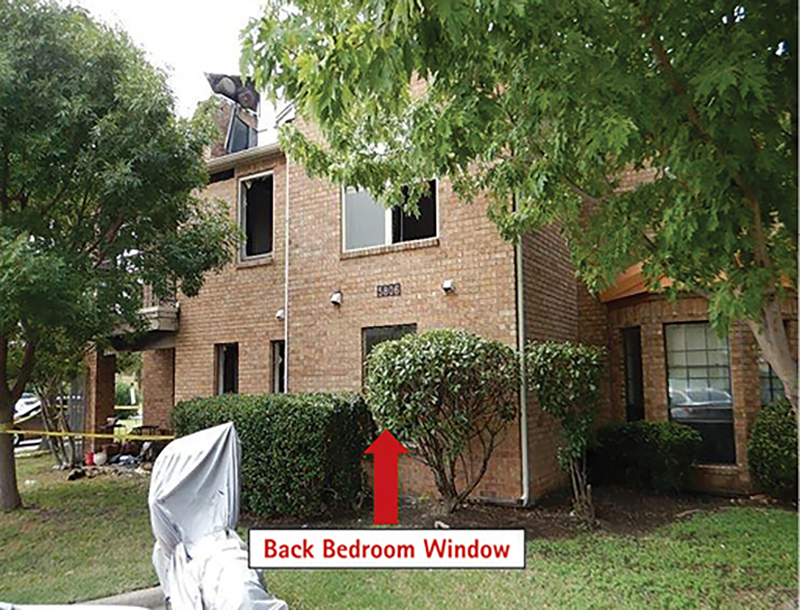By MICHAEL CLARK
On August 28, 2020, at 2234 hours, the Garland (TX) Fire Department (GFD) responded to a structure fire at 5806 Marvin Loving Drive. The structure was a two-story apartment of lightweight wood-frame construction with trusses used in the roof and floors. The complex was built in the late 1970s and was known to have some structural defects such as the floors feeling “spongy” or “bouncy” during emergency medical services (EMS) runs.
- Your First Mayday Shouldn’t be the Real Thing!
- Radio Messaging Under Warlike Conditions
- YOU MUST CALL MAYDAY FOR RIT TO WORK: WILL YOU?
- Mayday, Mayday, Mayday…
Each building in this two-story complex had eight individual apartments with four units on each end of the structure. The stairs were located in the middle section on either end for access to the second floor. The apartments affected by the fire for this incident were apartments 111 and 211. The complex was by a lake on the far south side of Garland, which takes extra time for units from other districts to arrive. The floor of 211 collapsed on top of the attack crew while they advanced through 111.
Arrival of Crews and Tactics
Ambulance 5 and Truck 5 were the first two arriving units, and both stated there was “fire in the balcony” of the two-story complex in their size-up. Both crews reported a large amount of “lazy” smoke surrounding the building. Truck 5 selected the “fast attack” command mode and assigned Ambulance 5 as initial rapid intervention company (IRIC). A “working fire” was declared, which in Garland means a second alarm is automatically dispatched to all commercial structures and apartment complexes.
On arrival, the scene was already full of bystanders, with people using garden hoses on the fire and kids running all around. One crew member said it felt like, “They were selling tickets to this event.” Several bystanders stated that a resident was still trapped inside 111. Truck 5, a quint, rides four up. While the driver established his own water supply, Firefighter 2 stretched an attack line to the front door of 111. The captain and Firefighter 1 searched 111 for the resident. While conducting an interior search, they reported finding cold, “stale” smoke from the floor to the ceiling with no heat. Truck 5’s captain used a thermal imaging camera (TIC) to survey the room and ceiling and reported that the TIC showed the same color on the ceiling with no obvious hot spots.
Another bystander approached the IRIC crew and stated that the resident believed to still be inside 111 had been recently transported to the hospital and was not currently at home. Truck 5’s captain and Firefighter 1 had completed a quick search of the apartment and did not find any victims; they backed out and rejoined Firefighter 2 to move the attack line up to the second floor. Bystanders were now saying they believed someone was currently at home and still inside 211.
Engine 4, the next-arriving apparatus, took command of the incident. Command reassigned Truck 5 as attack. Inside 211, attack found the apartment with clear visibility and no one home, as previously reported. Attack then took the line across the living room floor toward the balcony. While they advanced, the floor felt bouncy, like it normally does on EMS runs, but it became significantly worse as attack reached the balcony door and opened it. Firefighter 2 noticed smoke puffing up from around the hearth of the fireplace and relayed that information to his officer. Attack then notified Command that they believed the fire was in the void space of the floor and that they were backing out of 211. Attack took the line back down to 111 to pull ceiling and check the void space. With the fire extinguished on the balcony, Command acknowledged that attack was moving back down to 111 to search the void spaces.
Command conducted a 360° size-up and used a TIC to survey the window of the back bedroom of 111 on the D side. The window showed some signs of fire damage, so Command communicated to attack that he thought the fire was in the back bedroom. Instead of pulling ceiling, Attack immediately turned left, staying close to the wall, as they advanced toward the possible fire in the back bedroom. The floor of 211 collapsed on them, pinning Truck 5’s captain to the floor. Debris hit the two firefighters, knocking them into the kitchen area with the nozzle. The captain, trapped under the debris, was able to reach his radio and attempted to call a Mayday. After keying up, he instantly recognized a flow path of smoke through the debris and out the front door. Instead of finishing the Mayday call, he quickly accounted for his crew and instructed them to follow him out of the apartment. With crew integrity intact, he led them through the debris and out the front door to safety.
Just before the collapse, the IRIC crew stationed outside the A side front door of 111 reported hearing a loud “whoosh” sound. IRIC reported seeing a “fireball” shoot out the front door from 111. At the same time, Command stated he saw an orange glow through the window of the back bedroom of 111 from the ceiling to the floor. Command thought that a flashover had just occurred and immediately ordered the attack crew to evacuate the structure. Just prior to the collapse, two attack crew firefighters reported feeling a great deal of heat suddenly.
Truck 5’s captain acknowledged the evacuation order as he and his crew were already crawling through the debris. Command did not know that an interior collapse occurred until he came around to the front and saw IRIC helping the attack crew out of the apartment at the front door. A battalion chief had just arrived on scene and walked up to find Truck 5’s crew exiting the structure. All attack crew members were accounted for and safely outside.
The captain, complaining of shoulder pain, was transported immediately to the hospital, where it was discovered he suffered a torn rotator cuff. The two firefighters did not receive any injuries.





(1-5) Views of the apartment postcollapse. [Photos courtesy of the Garland (TX) Fire Department.]
Postincident Assessment
The collapse could possibly be attributed to a smoke explosion. Investigators determined that the fire started in some leaves and other debris that had accumulated in an opening where the balcony floor connected to the apartment wall. Cigarette butts were found in a jar on the balcony close to the opening. The investigators assumed the fire had been smoldering for a long time with the amount of damage found in the void spaces of the floor. With wind blowing directly into the balcony, smoke was able to accumulate in the void spaces of 211’s floor space. The truss spaces of the floor for this structure ran from the balcony on the D side to the opposite apartment’s balcony on the B side, allowing more smoke to accumulate deeper in the structure.
With the attack crew opening up the front doors on both floors and opening up the balcony door on the second floor, pressure differentials could have possibly been created, allowing the accumulated smoke to reach an ignition source. The loud “whoosh” reported by IRIC and the orange glow seen by Command are also indicators that a possible smoke explosion occurred. Checking the back bedroom after the event, the only fire damage found was a tear in the gypsum board of the ceiling and minor fire damage to some of the items in the room such as melted lamp shades. Most of the room did not show fire damage where Command reported seeing the orange glow throughout the room.
Communications for this event did not start off well, as delays occurred in dispatch from the initial tone-out to the actual assignment of crews. The delay added an extra minute to the response time of a lightweight, wood-frame structure. As previously stated, declaring a “working fire” in Garland on an apartment complex is an automatic second alarm. With other incidents going on in the city, a delay of three minutes occurred from the “working fire” declaration to the actual tone-out of the second alarm. The second alarm initially was assigned to the wrong operations channel, leading to more confusion. The first-arriving ambulance and engine stated their size-up was done over the radio while still on the dispatch channel and not on the assigned operations channel for the incident. All communications were sorted out with all crews on the dedicated operations channel for the incident. However, many National Institute for Occupational Safety and Health reports point to communications as a leading contributing factor to potential Maydays and line-of-duty deaths (LODDs).

(6) The A/D side corner of the complex. (Photos 6-8 by author.)

(7) The A side of the building.

(8) The D side of the building.
The entire sequence of events can be described as the “perfect storm of disruption.” From communication issues, multiple reports of victims trapped on different floors, and wind speeds in excess of 10 miles per hour (mph) directly into the balcony on fire, the recipe for a potential Mayday situation existed. The attack crews had changed floors twice searching for victims and had been searching for fire beyond the balcony for several minutes. Once Command stated that fire was in the back bedroom, attack did not finish pulling ceiling on the first floor to check for the possible void space fire they reported while on the second floor. If they had finished checking the ceiling first, they might not have advanced into the area of the collapse.
Considerations and Lessons Learned
Following are the considerations and lessons the GFD learned at this response:
- Take the time to review building construction, especially for structures inside your first-due district. Knowledge of the building’s construction, possible defects, and any other hazards found will help you be as prepared as possible for potential fires.
- Pull ceiling to create an inspection hole for any room filled with smoke. A quick inspection hole can provide a great deal of information about what steps to take next. You do not want to be trapped in a structure by fire above your head that could potentially cut off your means of egress.
- Always call a Mayday when you think you are in trouble. The officer here initially tried to call but quickly recognized the way out, which worked out perfectly this time. Calling a Mayday first is still the best practice to ensure Command is made aware of your predicament.
- Knowing how your TIC operates and verifying the actual temperature reading of the area scanned are imperative. The TIC showing an all-white screen with no obvious color contrasting was further reviewed for what the officer thought was a “whiteout.” Two common issues can cause a whiteout. One is fogging and the other is being too close to an object you are trying to scan. At the time of this incident, the instructions of the TIC that the GFD was using state an object must be greater than three feet away for the focal point to register. Anything less than three feet can possibly white out the camera. Fogging can be attributed to low temperatures, high moisture content from sprinklers, attack lines flowing, or cold smoke. With this incident occurring in a void space, the smoke being scrubbed would have been cold and possibly cause the whiteout. Wiping the lens, the screen, and the face mask can help alleviate issues with fogging. A third possible issue that could have led to the all-white image seen by Truck 5’s captain is called “thermal saturation,” which can occur when all objects in an area have absorbed all the energy they possibly can. When this saturation occurs, the energy will radiate back to the TIC as showing all objects with the same temperature for the area surveyed with the TIC. In other words, the screen would appear to not show any color contrasting signs of heat, as the attack officer found when he initially checked the ceiling. The white screen could lead someone to assume the area is clear.
- Smoke explosions require only a cool mixture of air and fuel in their flammable range to accumulate, usually in void spaces. Once this mixture encounters an ignition source, a violent explosion can occur. As a reminder, the only indicator of a potential smoke explosion is the presence of smoke. If you have cold smoke and buildings with known void spaces, an increased awareness from all crews is required for the possibility of a potential smoke explosion.
- The vent assignment can sometimes become just a tactical worksheet checkbox item that gets filled without a true need for a full vent crew. In this situation, Truck 5’s driver had already set up a fan outside the A side. With the ambulance setup crew outside as IRIC, they could have turned on the fan once the attack crew was ready for ventilation. Sometimes, setting the fan is all that is needed for ventilation and, many times, an entire crew is assigned this task. With the checkbox filled in, this crew can be forgotten about on the tactical worksheet, thus depleting resources that could have been in reserve or assigned to the rapid intervention crew (RIC).
- In Garland, the only prearrival assignment for working structure fires is that the second-due truck will be assigned RIC. The first-in ambulance is usually assigned IRIC and can be reassigned once the bigger RIC arrives. With the location of this incident on the far south side of the city, the RIC had to cover a long response distance and arrived 10 minutes 44 seconds after the first-due apparatus went fast attack. The actual collapse took place two minutes 45 seconds before the RIC arrived on-scene. Project Mayday’s 2019 report states that most LODDs occur within the first 12 minutes of an incident and 57% of all Maydays involved the first unit. The nearly 11-minute response time puts the RIC’s arrival right at the end of the mark of when most LODDs occur. The arrival time and RIC stating over the radio that “RIC is on scene” is just that—RIC is only on scene. RIC just being on scene does not include the time it takes to set up a tool cache, conduct a RIC 360˚ size-up, check with Command and safety to verify crew locations, and anything else needed to declare over the radio the benchmark of “RIC established.” The entire process of getting the RIC ready to deploy can take several minutes. In this incident, the collapse occurred eight minutes after the initial crew went to “fast attack.” For most other locations in Garland, the second-arriving truck is on scene much faster and the RIC is established sooner. During the critique of this incident, we determined we needed to do a better job of completing a RIC size-up for all incidents. If conditions exist that warrant establishing a RIC sooner, do not wait for the apparatus with the RIC prearrival assignment to get there. Assign any crew as RIC, especially if a full vent crew is not needed because of a positive pressure ventilation (PPV) fan already set up and ready to coordinate with the attack crew.
- Wind should be a major factor to consider during size-ups and making fireground decisions. Wind speeds for this incident coming off the lake were up to 15 mph directly into the balcony area. From National Institute of Standards and Technology studies, wind speeds of 10 mph are enough to create a wind-driven event. The only access to these apartments was on the A and D sides. With the wind blowing into the D side, setting up a PPV fan into the A-side front door could have been overcome by the wind and proven ineffective. Always factor wind into your size-up when making decisions.
- Consider a reset. If you are unable to locate the fire, communications are confusing, or any other obstacles are found, always consider potentially regrouping everyone back in the front yard and resetting expectations. A major challenge for company officers is processing new information from Command or other crews while also being able to stay focused on information you obtained yourself. In this incident, Command relayed where he thought the fire was located in the back bedroom. With adrenaline and possible frustration high from searching for the fire for a long time, it can be easy to forget about pulling ceiling to check the void space where you thought the fire was residing. Reining someone back in after releasing them on an assignment is the next challenge. We all have those firefighters who, if we let them loose to attack, will be very aggressive in getting that job done. As an officer, what can you do to stay focused on information you just found, process that new information, and pull your crew back in when they are charging toward a fire?
MICHAEL CLARK is a 19-year veteran of and a captain/paramedic with the Garland (TX) Fire Department, assigned to Truck 9. He served three years as the fire training lieutenant, responsible for training all new hires and helping deliver training to operations. He is also state certified as a master firefighter, instructor III—master, fire officer II, and incident safety officer.

